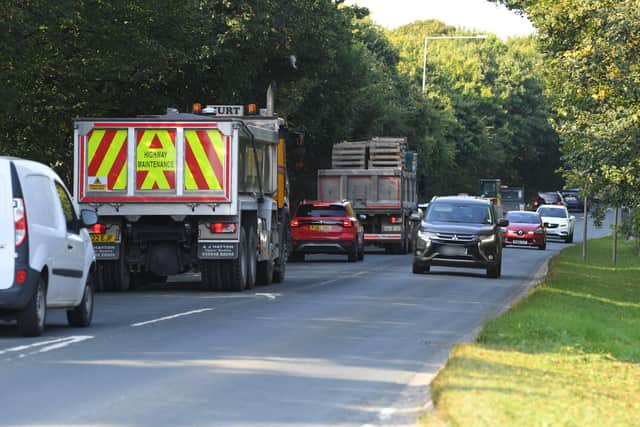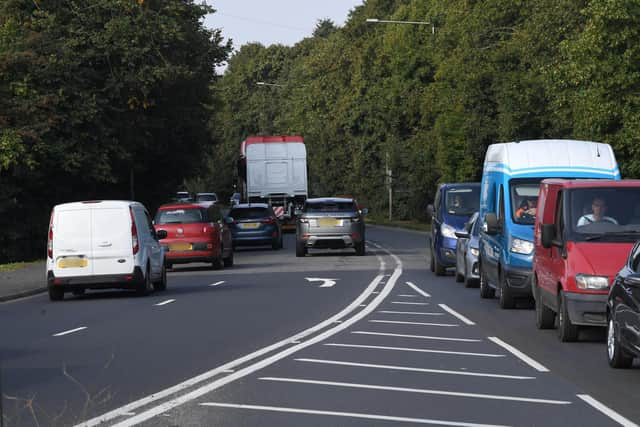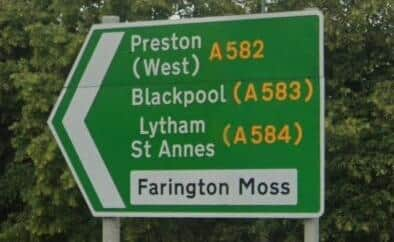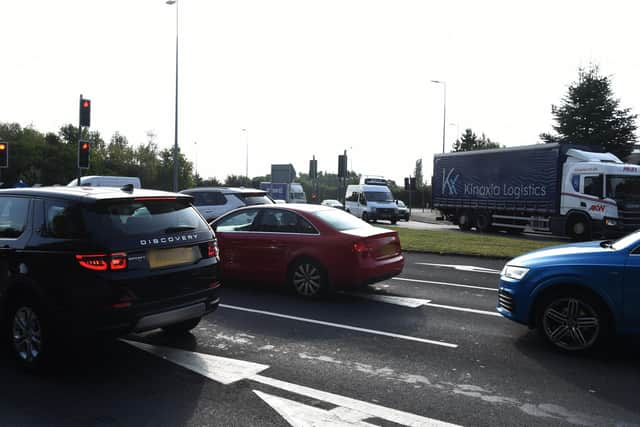Pickering's Farm: 1,100-home development could hinge on travel time increases of 'less than the length of a song on the radio'
and live on Freeview channel 276
The issue dominated the closing statements of the public inquiry into the proposed Pickering’s Farm development when the proceedings wrapped up last month.
Patrick Hanna, the inspector who chaired the three-week-long event, is now preparing a report in which he will make a recommendation to the government about whether or not to overturn South Ribble Borough Council’s refusal of permission for the controversial estate.
Advertisement
Hide AdAdvertisement
Hide AdAs he does so, he will no doubt have rows over Central Lancashire’s road network ringing in his ears. The subject was given days of detailed scrutiny during the main part of the hearing and then had a starring role in the summing up given by the barristers representing the council and the developer behind the long-planned scheme, which would swallow up a huge plot of land stretching from Penwortham Way through to Leyland Road.


Many of the contentious road-related issues debated during the course of the inquiry were revisited in the rounding-up session - including how the traffic generated by the development might affect journey times on existing routes and whether that could reasonably be classed as severe.
A suggestion by a senior Lancashire County Council highways official that a probable decrease in average speeds along the A582 of just one-mile-per-hour would have a negative impact on the driver experience was dismissed by the developer’s legal representative as lacking “credibility”.
Meanwhile, South Ribble’s counsel claimed that the use by the applicants of traffic data from April 2021 - during the third national Covid lockdown - was “unrepresentative” of current travel patterns, which, at certain peak times, are fast approaching a return to 2019 levels.
Advertisement
Hide AdAdvertisement
Hide Ad

However, it was a road that has not even been built yet - and the question of whether it ever will be - which received much of the attention during the closing submissions.
Several of the 11 reasons councillors on South Ribble’s planning committee advanced for refusing the Pickering’s Farm proposal late last year were based on their conclusion that it did not comply with the requirements of the authority’s local plan for the site - including the need to deliver the outstanding stretch of the so-called “cross-borough link road” (CBLR) as part of the development.
That east-west route - first envisioned as long ago as the 1970s - would run across the new estate, connecting Penwortham Way to the section of the CBLR running between The Cawsey and the A6, which finally opened in 2020.
South Ribble Borough Council claimed that in their Pickering’s Farm plans, housebuilder Taylor Wimpey and government housing delivery agency Homes England - which jointly made the pitch for planning permission - had failed to provide a “firm commitment” to provide what is regarded as a key piece of infrastructure.
Advertisement
Hide AdAdvertisement
Hide Ad

During his closing statement, Ian Ponter KC, representing the district authority, told the inquiry that previous pledges in that regard - made during the formation of the local plan and in another failed planning application for the plot two years ago - had now been “unceremoniously dropped”.
“There should be no doubt that, prior to the adoption of the local plan [in 2015], the appellants expressly promoted the allocation of land at Pickering’s Farm on the basis that it would deliver the remaining part of the CBLR.
“[Their] change of position is stark - [in] the current masterplan…reference to the CBLR is almost consigned to a footnote,” said Mr. Ponter, adding that the commitment was now merely to protect the necessary sections of land across a wider plot in order to allow the long-awaited link road to be laid.
However, in his final summary, Christopher Katkowski KC, representing Taylor Wimpey and Homes England as the appellants, said that such an assurance was all that was demanded by the local plan.
Advertisement
Hide AdAdvertisement
Hide Ad

The current proposals for 1,100 homes would see the development of the majority of the site identified as Pickering’s Farm - which is actually made up of a number of different agricultural plots - occupying two thirds of its surface area and providing 82 percent of the 1,350 properties earmarked for it by the borough council.
Mr. Katkowski told the hearing that the policy document did not require the developer of part of that wider location “to build or pay for the whole of the stretch of the CBLR as it passes through the allocated site, let alone a new bridge across the West Coast Mainline, which is one of the options, the other [being] improving the existing [Bee Lane] bridge”.
“The appeal schemes would deliver, as in build…some 1.08km [of the link road]...at a cost to the appellants of over £5m. This would amount to some 89 percent of the CBLR as it crosses the larger, allocated site - leaving in the order of 130 metres to be built on the in-between land.
“In anyone’s book, this should amount to a substantial contribution to the delivery of the CBLR,” Mr Katkowski contended.
Advertisement
Hide AdAdvertisement
Hide AdHe added that the proposal by Taylor Wimpey and Homes England would generate around £7.6m in community infrastructure levy payments - potentially rising to £10m if and when the whole allocated site is developed - which he said could be used to fund what would then be the final remaining part of the CBLR, a fact which he said meant that the council was not a “powerless bystander” in the situation.
Earlier in the inquiry, South Ribble leader Paul Foster had accused the developer of creating nothing more than a “long cul-de-sac”.


“Such an estate road would be required for a development of this size, whether there was a requirement for a cross-borough link road or not,” he said.
In his closing statement, Mr. Ponter said that there was no guarantee that the community infrastructure levy monies would be sufficient to complete the CBLR, estimates for which range from £2m to £12.5m, as a result of uncertainties over the need for land purchasing and the cost of accessing the rail network to undertake the job.
Advertisement
Hide AdAdvertisement
Hide AdThe applications made by Taylor Wimpey and Homes England had sought outline permission for up to 920 homes off Penwortham Way – including a local centre for retail, employment and community uses, a two-form entry primary school and green infrastructure – and another for up to 180 properties to the east of the site, close to the railway line.
South Ribble Council requires proposals for any part of the overall Pickering’s Farm site - which is the largest piece of land allocated for new housing in the district’s local plan - to be accompanied by a masterplan to ensure that the “comprehensive development” of the wider area is not compromised.
The authority concluded that the submitted document did not meet the borough’s “policy requirements” - and rejected both it and the associated housing applications.
However, Mr. Katkowski argued in his closing submission that the proposals were in tune with the local plan when it was “read as a whole”.
Advertisement
Hide AdAdvertisement
Hide AdBut he also said that even if the Secretary of State came to a different conclusion, the applications should nevertheless be approved in view of the ”extensive public benefits [they] would bring, including the much-needed 30 percent [proportion of] affordable housing”.
Mr. Ponter said that while such benefits were “acknowledged”, they should not come “at the cost of achieving a proper, comprehensive development of the Pickering’s Farm allocation that delivers important infrastructure and meets the expectations and requirements of the local plan”.
As the inspector chairing the public inquiry, Patrick Hanna would usually make the final decision about whether or not to uphold the council’s refusal of planning permission or reverse it.
However, as the Lancashire Post revealed back in July, the government has opted to take the rare step of “recovering” the appeals, meaning that the Levelling Up Secretary - then Michael Gove, but now Simon Clarke - will get the ultimate say after intervening in the process because the proposed development would “significantly impact” on the government's aim to “create high quality, sustainable, mixed and inclusive communities”.
Advertisement
Hide AdAdvertisement
Hide AdThe inquiry closed on 9th September, but it was not until the end of last week that the deadline passed for the submission of the agreement on the undertakings that would be required as part of any planning permission for the development, should it be granted.
‘ONE MILE AN HOUR WOULD MAKE ALL THE DIFFERENCE’
A senior Lancashire County Council highways officer told an earlier part of the Pickering’s Farm inquiry that he had concerns about the potential impact of the development on the road network - and took issue with the methodology used by the applicants to suggest that it would not be a severe one.
Neil Stevens, strategic highways planning manager at the authority, said that “mitigation” work would be required at a range of junctions in order to enable them to cope with the extra traffic, as several of them were already operating above their capacity.
He highlighted existing delays at three linked junctions in the Tardy Gate area - where Watkin Lane meets Brownedge Road and, separately, Jubilee Road; and also the intersection between Leyland Road and Coote Lane. Mr. Stevens said that the hold-ups experienced by public transport along that corridor were “only going to get worse over time”.
Advertisement
Hide AdAdvertisement
Hide AdHe also warned that improvements already planned - as part of forthcoming housing developments - to the traffic light-controlled roundabout junction between the A582 Lostock Lane/Farington Road, Stanifield Lane and Watkin Lane would need to be enhanced further.
However, in what were at times testy exchanges, Christopher Katkowski QC [as he and Ian Ponter were for that part of the inquiry which took place before the Queen’s death] pressed Mr. Stevens on whether journey time increases predicted by Taylor Wimpey and Homes England in their application could possibly be considered severe in the “ordinary English meaning of the word”.
The inquiry heard that modelling carried out on behalf of the appellants showed that, along the A582 from Golden Way to junction 29 of the M6, journeys were likely to lengthen during the busiest hour of the morning peak by two minutes and 43 seconds for southbound traffic and by one minute and 52 seconds for vehicles heading northbound.
Within the main hour of the evening peak, travel times southbound were forecast to increase by two minutes and seven seconds and by two minutes and 20 seconds in the opposite direction.
Advertisement
Hide AdAdvertisement
Hide AdMr. Katkowski asked Mr. Stevens whether he was really saying that “increases in peak hours of less than the time [it takes] to listen to one song on your radio…would be correctly and aptly described as severe in the sense of being very great in terms of their impact?”
“I would say yes,” the highways official replied, before later explaining that, by considering journey times “in isolation”, he did not actually believe it was possible to make a judgement about the severity of effect.
For that reason. Mr. Stevens repeatedly brought the discussion round to the potential impact of the Pickerings Farm plans on vehicle speeds - something which he said offered “a greater understanding of…the quality of [a] journey…to individual drivers”.
Within a 108-page document of evidence, he noted that average evening rush hour speeds along the Preston-bound section of the A6 and A582 corridor - between the M6 junction and the ‘tank roundabout’ - would decrease from an already “incredibly low” 7.6 miles-per-hour to 6.5 miles-per-hour in the wake of the development.
Advertisement
Hide AdAdvertisement
Hide AdWhen Mr. Stevens suggested that such a slowdown would also be severe, it drew incredulity from the appellants' barrister.
“It’s already slow [and] it becomes a tad slower - it’d be barely perceptible…no-one would know if they were driving a mile an hour slower,” Mr. Katkowski declared.
However, Mr. Stevens argued that a one-mile-per-hour reduction was severe in this context - precisely because average speeds at peak time were so slow to start with.
The two sides also criticised each other’s attempts at modelling what motoring in the area would look like if and when Pickering's Farm is developed.
Advertisement
Hide AdAdvertisement
Hide AdChristopher Katkowski suggested that Lancashire County Council’s approach sought to treat individual junctions as standalone entities at which traffic arrived “as if by magic”, on the assumption that it did not get held up at other junctions along the way, which were assumed to be problem-free when that was not the case. He said that such a theoretical scenario was “literally unreal”.
But Mr. Stevens insisted that it was nevertheless important to consider individual pinchpoints in turn.
KEEPING THE LANES QUIET
The inquiry heard that the Pickering’s Farm plans had been designed in a way to minimise the likelihood of traffic from the development leaking onto the existing rural lanes, along which walking and cycling will be encouraged.
Mike Axon, a transport masterplanning expert and a director with Vectos - the company which produced the transport assessment submitted as part of the planning application - told the hearing that the road layouts would make it “difficult for some, almost impossible for others, to actually make the turn” to gain access to the lanes.
Advertisement
Hide AdAdvertisement
Hide AdHe added: “I think if it did a 10-point turn, a small car might just about manage it.”
An idea was also floated at the inquiry for access points to the lanes to be covered by automatic number plate recognition cameras in order to prevent unauthorised access.
However, Lancashire County Council’s strategic highways planning manager, Neil Stevens, said that he would not want his own child to walk the lanes after the development was completed, because of the potential speeds of those vehicles which do manage to get onto them.
But Chris Katkowski QC, representing the appellants, said that £786,000 worth of upgrade works had been negotiated with County Hall’s public rights of way team which could be secured via a planning condition.
Only 40 of the proposed 1,100 new homes will be accessed via the Bee Lane bridge on the eastern side of the site.
